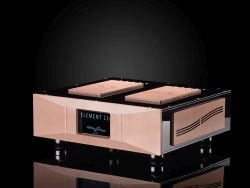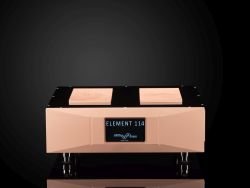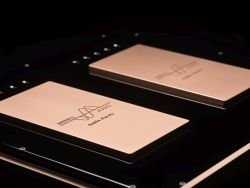Press Release: https://www.pr.com/press-release/784207
FOR IMMEDIATE RELEASE: 3rd May 2019
Worlds ultra-fast power transistor Gallium Nitride (GaN) used again on 3rd Power Amplifier from Merrill Audio Advanced Technology Labs, LLC
BERNARDSVILLE, New Jersey, USA - Zero Feedback, Zero Dead time and bottomless noise floor using Gallium Nitride (GaN) transistors on the ELEMENT 114 Stereo Power Amplifiers from Merrill Audio make it simply one of the best amplifiers available. Merrill Audio is very excited to release this new advanced technology at a lower price point. Utilizing trickle down technology from the award winning ELEMENT 118 and ELEMENT 116 Monoblock Power Amplifiers released last year. The Merrill Audio ELEMENT 114 ZXOL proprietary design technology leaps ahead of all other Class D implementations and provides more detail and immediacy almost than almost any amplifier in any amplifier class. The Musical detail, experience and immediacy along with the immediately noticeable ultra-low noise floor takes music reproduction to a whole new experience. It only takes an instant to realize your listening to something quite special.
Using advanced Gallium Nitride (GaN) transistors and advanced PCB design techniques, the dead time is reduced to zero, which removes any distortion. Dead time is the time the MOSFET transistor takes to discharge or charge when changing states. Since there is no dead time distortion, the ZXOL proprietary design also has Zero feedback. With Zero feedback there is much more detail, more information and much greater immediacy all with a sense of ease and openness. The combination is what we refer to as the Merrill Audio proprietary ZXOL, which stands for zero crossing, open loop design. With zero dead time, there is little heat loss and lower temperatures which allows for more precise operation of the amplifier and longer lasting, more stable components.
The Merrill Audio ELEMENT 114 Stereo Amplifier, just like the ELEMENT 116 and ELEMENT 118 utilizes a custom LLC resonant power supply with a custom transformer as an inductor. This ultra-low noise power supply gives the ELEMENT 114 amplifiers its seemingly limitless supply of power and ultra-low noise floor while in operation at full power.
The Merrill Audio ELEMENT 114 Stereo Amplifier, like its higher end amplifiers are load invariant, with the Merrill Audio ELEMENT 114 delivering power across all complex loads that doubles 200 watts into 8 ohms, 400 watts into 4 ohms and 800 watts into 2 ohms. Full protection circuity is built in, with no clipping using a fast signal reduction design to avoid clipping on the outputs.
The Merrill Audio ELEMENT 114 Stereo Amplifier comes in a gorgeous Stereo package, with Polished Black Nickel and Rose Gold Face plate and accents. A 20Amp AC inlet is use for tighter connection. The XLR input has a full Teflon body with rhodium plated silver pins. The speaker binding posts are Pure copper speaker. Gain is 26 dB, 400 watts into 4 ohms at 0.08% distortion. Early listeners were startled with the most realistic reproduction of music they have heard from any amplifier. The Merrill Audio ELEMENT 114 Stereo Amplifier is priced at USD$15,000. This carries forward the award winning ELEMENT series of Amplifiers from Merrill Audio and is the latest of all the award winning audio components.
For more information
Merrill Audio Advanced Technology Labs, LLC
ELEMENT-114@MerrillAudio.net
www.MerrillAudio.net
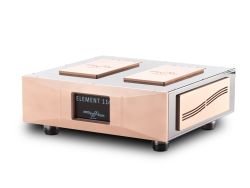
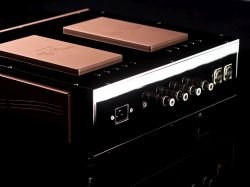
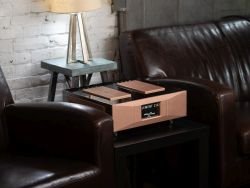
FOR IMMEDIATE RELEASE: 3rd May 2019
Worlds ultra-fast power transistor Gallium Nitride (GaN) used again on 3rd Power Amplifier from Merrill Audio Advanced Technology Labs, LLC
BERNARDSVILLE, New Jersey, USA - Zero Feedback, Zero Dead time and bottomless noise floor using Gallium Nitride (GaN) transistors on the ELEMENT 114 Stereo Power Amplifiers from Merrill Audio make it simply one of the best amplifiers available. Merrill Audio is very excited to release this new advanced technology at a lower price point. Utilizing trickle down technology from the award winning ELEMENT 118 and ELEMENT 116 Monoblock Power Amplifiers released last year. The Merrill Audio ELEMENT 114 ZXOL proprietary design technology leaps ahead of all other Class D implementations and provides more detail and immediacy almost than almost any amplifier in any amplifier class. The Musical detail, experience and immediacy along with the immediately noticeable ultra-low noise floor takes music reproduction to a whole new experience. It only takes an instant to realize your listening to something quite special.
Using advanced Gallium Nitride (GaN) transistors and advanced PCB design techniques, the dead time is reduced to zero, which removes any distortion. Dead time is the time the MOSFET transistor takes to discharge or charge when changing states. Since there is no dead time distortion, the ZXOL proprietary design also has Zero feedback. With Zero feedback there is much more detail, more information and much greater immediacy all with a sense of ease and openness. The combination is what we refer to as the Merrill Audio proprietary ZXOL, which stands for zero crossing, open loop design. With zero dead time, there is little heat loss and lower temperatures which allows for more precise operation of the amplifier and longer lasting, more stable components.
The Merrill Audio ELEMENT 114 Stereo Amplifier, just like the ELEMENT 116 and ELEMENT 118 utilizes a custom LLC resonant power supply with a custom transformer as an inductor. This ultra-low noise power supply gives the ELEMENT 114 amplifiers its seemingly limitless supply of power and ultra-low noise floor while in operation at full power.
The Merrill Audio ELEMENT 114 Stereo Amplifier, like its higher end amplifiers are load invariant, with the Merrill Audio ELEMENT 114 delivering power across all complex loads that doubles 200 watts into 8 ohms, 400 watts into 4 ohms and 800 watts into 2 ohms. Full protection circuity is built in, with no clipping using a fast signal reduction design to avoid clipping on the outputs.
The Merrill Audio ELEMENT 114 Stereo Amplifier comes in a gorgeous Stereo package, with Polished Black Nickel and Rose Gold Face plate and accents. A 20Amp AC inlet is use for tighter connection. The XLR input has a full Teflon body with rhodium plated silver pins. The speaker binding posts are Pure copper speaker. Gain is 26 dB, 400 watts into 4 ohms at 0.08% distortion. Early listeners were startled with the most realistic reproduction of music they have heard from any amplifier. The Merrill Audio ELEMENT 114 Stereo Amplifier is priced at USD$15,000. This carries forward the award winning ELEMENT series of Amplifiers from Merrill Audio and is the latest of all the award winning audio components.
For more information
Merrill Audio Advanced Technology Labs, LLC
ELEMENT-114@MerrillAudio.net
www.MerrillAudio.net





